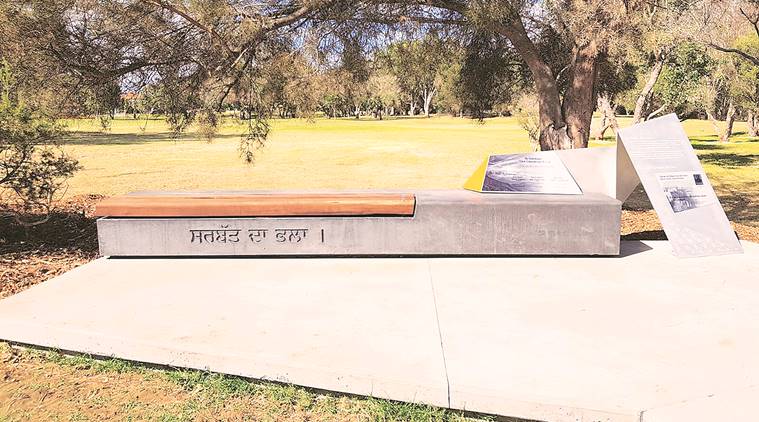 The trail tells the significance of Adenia Park for Sikhs, its history, and contribution of Sikhs in the development of this British colony (Source: Australian Sikh Heritage Association)
The trail tells the significance of Adenia Park for Sikhs, its history, and contribution of Sikhs in the development of this British colony (Source: Australian Sikh Heritage Association)
Sikh Australian Heritage Trail, an open-air museum, narrating the history of Sikhs in Western Australia (once a British colony called Swan River Colony), was inaugurated at Bicentennial Adenia Park at Riverton in City of Canning on April 17. The project, jointly executed by the local government and the Sikh community, highlights over 100 years of Sikh struggle to get cremation rights in a foreign land. The trail has interpretative panels that narrate the history of Sikhs who migrated to Australia in the early 1800s. They worked as hawkers, pulled horse wagons and camels, and played a major role in exploring goldfields in Western Australia (now a state with Perth as capital).
A beautifully landscaped path leads to the Sikh Heritage Cremation Site, the first piece of land which was allotted to Sikhs legally for cremations in 1932. The site is now a part of Adenia Park in Riverton. The District Historical Society (City of Canning) had gifted a plaque to the Sikh community on November 22, 1992, which has been installed there. Amarjit Singh Pabla, 65, one of the founding members of Australian Sikh Heritage Association, over the phone, said that the trail tells the significance of Adenia Park for Sikhs, history of Sikhs in Western Australia and contribution of Sikhs in development of this British colony.
“From 1829 to 1929, cremations were not allowed at Swan River Colony for Sikhs. They petitioned the government for many decades to legalise the practise. This culminated in a change in the law with the passing of Cremations Act 1929. In 1932, two western Australian Sikhs, Bhola Singh and Massa Singh were allocated half an acre of land by the state government. The site was formally gazetted as a Sikh cemetery. At the time, Sikh population in Western Australia dwindled to some 50 Sikhs, and only a few cremations were carried out on site. Now it is a part of Adenia Park, so that visitors can know about this struggle,” he said.
“Those were the days when Sikh cremations used to become headlines of Australian papers because it wasn’t allowed. They called it ‘burning’ of bodies. Still Sikhs continued their struggle. Today we have electric crematoriums here,” said Pabla.
The museum also narrates the stories of Sikh hawkers who used to run horse wagons and camel trains in countrysides. The locals, to a great extent, depended on them as there was no proper transportation system then. Massa Singh, Veer Singh, Nehal Singh and Herman Singh were among the first Sikh hawkers whose photos have been extracted and installed in the museum. “Sikh cameleers ran camel trains in Australia as the animal easily carried heavy goods and required less water, making it easy to travel to the goldmines,” said Pabla.
The museum also displays details of at least 19 ANZACs (the joint army of Australia and New Zealand, which participated in World War I). “At least 19 Sikhs were enlisted in the Australian Imperial Force and New Zealand Expeditionary Force for WWI. Old records say they were from Nawanshahr, Jalandhar, Ludhiana, Ferozepur, Lahore, Sultanpur Lodhi, Hoshiarpur, and Jandiala, besides other places in undivided Punjab. We tied up with National Archives of Australia to extract these details,” said Pabla.
The museum also remembers the famous Sikh professional wrestler Buttan Singh who arrived in Western Australia in 1900, and flying officer Manmohan Singh, who led the British Indian Air Force at the outbreak of World World II and attained martyrdom on March 3 ,1942, in an air attack by Japan at Broome in Western Australia. Sikhs who initiated farming as a profession in Australia including Charr Singh, Kheva Singh, Spoon Singh, Mohan Singh, Gurdit Singh and Mohan Singh. One of the panels at the museum recounts: Australians used skills of Sikh farmers in handling animals and in return trained Sikhs in the use of agricultural machinery.
The museum was inaugurated by two ministers of state of Western Australia — Stephen Dawson, minister of Environment, and Bill Johnston, minister of Asian Engagement. Nearly Rs 1.38 crore (2.74 lakh Aus dollars) have been spent on the project with joint funding from Lotterywest Grant, the Department of Biodiversity, Conservation and Attractions and the Sikh community of Western Australia.